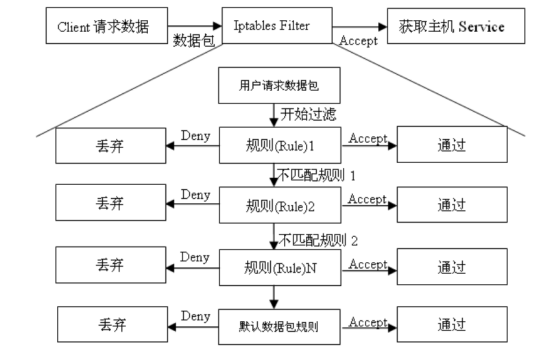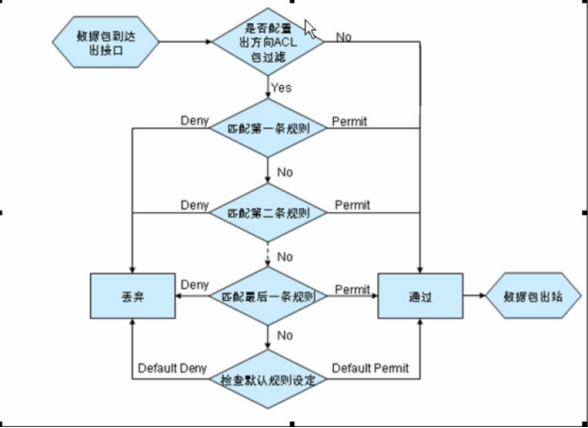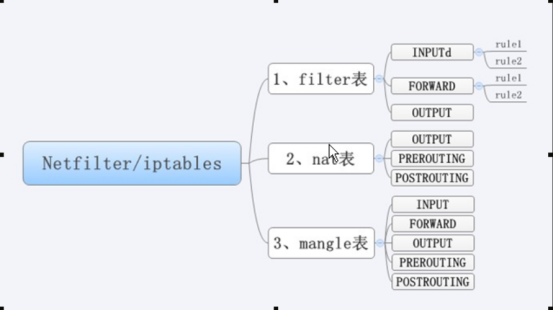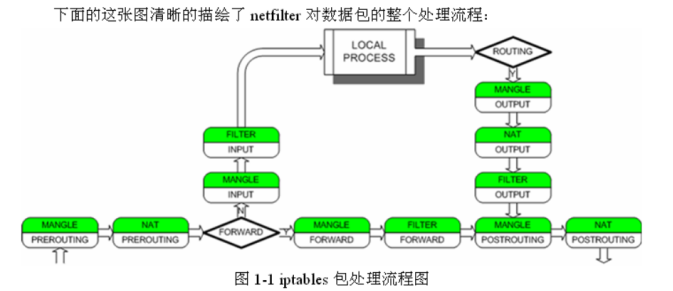iptables
1、1 iptables防火墙简介
Netfileter/iptables (以下简称iptables)是nuix/linux 系统自带的优秀且完全免费的基于包过滤的防火墙工具、它的功能十分强大、使用非常灵活、可以对流入、流出及流经服务器的数据包进行精细的控制。特别是它可以在一台非常低配置下跑的非常好。提供400台机器的办公上网共享服务丝毫不逊色数万RMB企业级专业路由器防火墙
Iptables 是linux2.4及2.6内核中集成的服务、其功能与安全性比老一辈ipvfwadm、ipchanins强大的多、一般认为iptables工作在OSI七层的、二、三层、四层。
1、2 iptables 名词和术语
不少刚接触到iptables的初学者会被iptables防火墙的相关名词搞的很晕、不知道其所云的具体意思、本章不会像某些书籍一样长篇大论、而是以最基本的能让大家容易理解。
1、2、1 什么是容器
容器就是装东西的。如(箱、包、坛、)、容器就是用来包装或转载物品的存寄器、在iptables里的呢、就是用来描述这种包含或者说术语的关系、喜爱按我就来说说这些包含关系
1、2、2 什么是Netfileter/iptables
Netfileter是表(tables)的容器,(还不知道啥意思的,请网上看)。这样解释大家肯定还晕、举例、如果吧Netfileter看成某小区的一栋大楼、那么表(tables)就是楼里的其中的一套房子。这套房子表(tables) 就属于这栋楼“Netfileter”。比如、你们家所在的小区所在楼当成netfileter
1、2、3 什么是表(tables)
表(tables)是链的容器、及所有的链(chains)都是属于表(tables),如上,如果把Netfileter看成某个小区的一栋楼、那么表(tables)就是楼里的某一套房子、比如你们家住的房子。当然了、表(tables)可能不止一个!
1、2、4 什么是链(chains)?
链(chains)是规则(Policys)的容器、链属于表,接上、如果表(tables)当做一套房子、那么链(chains)那么可以说是房子里的家具(桌子、柜子等)。每一套房子都可能会有桌子柜子等、
1、2、5 什么是规则(Policy)
规则(policy)就比较容易理解了、柜子(policy)属于链(chains)。就是iptables一系列过滤信息和具体操作方法、可以理解为购买什么家具、并且如何摆放、设计的更符合要求等、
1、2、6 整理个表格如下
描述完了基本术语我们画个形象的表格帮我们理解记忆下:
Netfileter/iptables | 表(tables) | 链(chains) | 规则(policy) |
小区的一栋楼 | 楼里的房子 | 房子里的柜子 | 增加、摆放的规则 |
1、3 iptables工作流程
前面的介绍已经提到。Iptables 是采取数据包过滤机制工作的,所以它会对请求的数据包的包头数据进行分析、并根据我们预先设定的规则进行匹配来决定是否可以进入、流出、流经主机。下面我们以 iptables 进入主机进行过滤的流程图为例子

提示:
防火墙规则的执行顺序认为从前到后依次执行、遇到匹配的规则就不在继续向下检查、
如果遇到不匹配的规则则会继续向下进行。
重点: 匹配上了拒接规则也是匹配。因此不在继续向下进行、这一点大家要注意、
例如:同时执行了以下规则
[root@Nagios2 ~]# iptables -A INPUT -p tcp --dport 3306 -j DROP
[root@Nagios2 ~]# iptables -A INPUT -p tcp --dport 3306 -j ACCEPT
此时通过命令 telnet 192.168.132.194 3306 检查3306是不通的。原因就是telnet请求以匹配上了拒接规则、因此不会在找下面的允许规则、如果需要telnet 192.168.132.194 3306 连通、可以把ACCEPT规则中的-A 改为-I 即为 iptables –I INPUT –p tcp –dport 3306 –j ACCEPT 把允许规则防御INPUT链的第一行生效
再来一个流程的图例:此里来自于交换机中acl过滤。如iptables 流程几乎一模一样。
入站数据包流程图:

出站数据包:

小提示:对于交换机的acl数据包过滤。除了顺序匹配外,还有深度匹配。即读完所有的再去匹配。匹配最精确的规则。
1、4 iptables 的表(tables) 和链(chains)
描述完iptables术语后、相信大家对iptables的表和链有了初步的了解了、默认情况下。Iptables,根据功能和表的定义划分、最常用的有三个表,分别是filter,nat mangle.其中每个表又有各自包含不同的操作链(chains)
小提示:如果你执行man iptables 可以发现还有raw表,不过我们不用理会它。平时我们几乎用不到。
西面的表格展示了表和链的对应关系。

特殊提示这里。我们画个思维辅导图辅助记忆

1、4、2 iptables 的filter表介绍
Filter表 | 和主机自身相关、负责防火墙(过滤本机流入、流出数据包)。 是iptables默认使用的表、这个表定义了三个链(chains)说明如下 | |
| INPUT | 负责过滤所有目标地址是主机(防火墙)地址的数据包、通俗的讲、就是过滤进入主机的数据包。 |
| FORWARD | 负责转发流经主机但不进入本机的数据包、起转发作用、和NAT表关系很大、后面会详细介绍 |
| OUTPUT | 处理所有原地址是本机地址的数据包、通俗的讲就是处理从主机发出去的数据包。 |
对于filter表的控制是我们实现本机防火墙功能的重要手段。
1、4、3 iptabls 的nat表介绍
NAT表 | 是网络地址转换的意思。即负责来源与目的IP地址和port的转换、和主机本身无关。一般用于局域网多人共享上网或者内网IP映射外网IP及不同端口转换服务等功能。Nat表的功能很重要、这个表定义了三个链(chains) | |
| OUTPUT | 主机发出去的数据包有关、在数据包路由之前改变主机产生的数据包的目的地址等。 |
| PREROUTING | 在数据包刚到达防火墙时、进行路由判断之前执行的规则、改变包的目的地址(DNAT功能)、端口等(通俗比喻,就是收信时、根据规则重写收件人的地址、这看上去不地道啊、)把公司IP映射到局域网的机器上、此链多用于把外部IP地址端口的服务、映射为内部IP地址及端口 |
| POSTROUTING | 在数据包离开防火墙时进行路由判断之后执行的规则、改变包的源地址(SNAT)、端口等(通俗比喻、就是寄信时写好发件人的地址、要让人家回信是能够有地址可回)刺链多用于局域网共享上网,把所有局域网的地址、转换为公网地址上 |
1、4、4 iptables 的mangle表介绍
Mangle | 主要负责修改数据包中特殊的路由标记,如TTL、TOS、MARK等、这个表定义了5个链(chains) | |
| INPUT | 同filter表的INPUT |
| FORWARD | 同filter表的FORWARD |
| OUTPUT | 同fileter表的OUTPUT |
| PREROUTING | 同nat表的PREROUTING |
| POSTOUTING | 同nat表的POSTOUTING |
由于这个表与特殊路由标记有关、一般在生产运维工作中、我们很少用到这个mangle表。我们就不做详细介绍了、
1、5 iptables 的表与链的工作流程

2、iptables 命令规则
2、1 iptables命令帮助信息。
[root@Nagios2 ~]# iptables -h
iptables v1.4.7
Usage: iptables -[AD] chain rule-specification [options]
iptables -I chain [rulenum] rule-specification [options]
iptables -R chain rulenum rule-specification [options]
iptables -D chain rulenum [options] ###删除规则
iptables -[LS] [chain [rulenum]] [options]
iptables -[FZ] [chain] [options]
iptables -[NX] chain
iptables -E old-chain-name new-chain-name
iptables -P chain target [options] #(其中-p等同于 –policy规则)
iptables -h (print this help information)
Commands:
Either long or short options are allowed.
提示:这款请注意。长格式短格式命令都可用、为了打字我们习惯于端格式
--append -A chain Append to chain
--delete -D chain Delete matching rule from chain
--delete -D chain rulenum
Delete rule rulenum (1 = first) from chain
--insert -I chain [rulenum]
Insert in chain as rulenum (default 1=first)
--replace -R chain rulenum
Replace rule rulenum (1 = first) in chain
--list -L [chain [rulenum]]
List the rules in a chain or all chains
--list-rules -S [chain [rulenum]]
Print the rules in a chain or all chains
--flush -F [chain] Delete all rules in chain or all chains
--zero -Z [chain [rulenum]]
Zero counters in chain or all chains
--new -N chain Create a new user-defined chain
--delete-chain
-X [chain] Delete a user-defined chain
--policy -P chain target
Change policy on chain to target
--rename-chain
-E old-chain new-chain
Change chain name, (moving any references)
Options:
[!] --proto -p proto protocol: by number or name, eg. `tcp'
[!] --source -s address[/mask][...]
source specification
[!] --destination -d address[/mask][...]
destination specification
[!] --in-interface -i input name[+]
network interface name ([+] for wildcard)
--jump -j target
target for rule (may load target extension)
--goto -g chain
jump to chain with no return
--match -m match
extended match (may load extension)
--numeric -n numeric output of addresses and ports
[!] --out-interface -o output name[+]
network interface name ([+] for wildcard)
--table -t table table to manipulate (default: `filter')
--verbose -v verbose mode
--line-numbers print line numbers when listing
--exact -x expand numbers (display exact values)
[!] --fragment -f match second or further fragments only
--modprobe=<command> try to insert modules using this command
--set-counters PKTS BYTES set the counter during insert/append
[!] --version -V print package version.
[root@Nagios2 ~]#
2、2 实践iptables 命令规则
2、2、1 启动并查看iptables
[root@Nagios2 ~]# /etc/init.d/iptables start
iptables: Applying firewall rules: [ OK ]
[root@Nagios2 ~]#
查看iptables 的所有链和规则
Iptables –L –n 或者 iptables –L –n –t filter 或者 iptables –L –n –x –v
中文说明:
-L :列出一个或所有链的规则
-v:显示详细信息、包括每条规则匹配包数量和匹配字节数
-x:在v的基础上、进制自动单位换算(K,M)
-n: 只显示IP地址和端口号码。不显示域名和服务名称
-t : 接表名、如果不加-t,默认就是 –t filter
[root@Nagios2 ~]# iptables -L -n
Chain INPUT (policy ACCEPT)
target prot opt source destination
ACCEPT all -- 0.0.0.0/0 0.0.0.0/0 state RELATED,ESTABLISHED
ACCEPT icmp -- 0.0.0.0/0 0.0.0.0/0
ACCEPT all -- 0.0.0.0/0 0.0.0.0/0
ACCEPT tcp -- 0.0.0.0/0 0.0.0.0/0 state NEW tcp dpt:22
REJECT all -- 0.0.0.0/0 0.0.0.0/0 reject-with icmp-host-prohibited
Chain FORWARD (policy ACCEPT)
target prot opt source destination
REJECT all -- 0.0.0.0/0 0.0.0.0/0 reject-with icmp-host-prohibited
Chain OUTPUT (policy ACCEPT)
target prot opt source destination
默认是filter的,没有加 –t 默认查看的就是如果想要查看NAT的表
[root@Nagios2 ~]# iptables -L -n -t nat
Chain PREROUTING (policy ACCEPT)
target prot opt source destination
Chain POSTROUTING (policy ACCEPT)
target prot opt source destination
Chain OUTPUT (policy ACCEPT)
target prot opt source destination
[root@Nagios2 ~]#
2、2、2 清除默认规则
为了从头学起,我们需要首先清除掉所有的默认规则、具体的命令为
Iptables –F ###清除所有规则
Iptables –X ####删除用户自定义的链
Iptables –Z ####链的计数器清零
提示:默认情况下,我们清除规则是对filter表的操作、如果是nat表、我们需要iptables –t nat –F
实例演示2:
[root@Nagios2 ~]# iptables -F
[root@Nagios2 ~]# iptables –flush
2、2、3 iptables 规则语法
1)禁止ssh默认的22端口
[root@Nagios2 ~]# iptables -A INPUT -p tcp --dport 22 -j DROP
[root@Nagios2 ~]# iptables -t filter -A INPUT -p tcp --dport 22 -j DROP
提示:
1、iptables 默认用的就是filter表 。因此,以上两条命令等价。
2、其中INPUT DROP 等关键词要大写的
3、行为参数
--jump -j target
提示: target 的常见的处理方法有ACCEPT(接受),DROP(丢弃),REJECT(拒接)其中、一般不使用REJECT行为、REJECT会带来安全隐患、在这里我们只需要记住ACCEPT(接受)、DROP(丢弃)即可、
扩展:删除设定的规则
iptables –D INPUT –p tcp –dport 22 –j DROP
删除规则法二:
首先显示规则号
[root@Nagios2 ~]# iptables -L -n --line-numbers
Chain INPUT (policy ACCEPT)
num target prot opt source destination
1 DROP tcp -- 0.0.0.0/0 0.0.0.0/0 tcp dpt:21
Chain FORWARD (policy ACCEPT)
num target prot opt source destination
Chain OUTPUT (policy ACCEPT)
num target prot opt source destination
[root@Nagios2 ~]#
[root@Nagios2 ~]# iptables -D INPUT 1
删除规则三:
执行iptables –F 清除所有的规则,临时生效。重启防火墙或重启计算机失效
删除规则法四:
重启防火墙/etc/init.d/iptables restart
- 禁止10.0.0.0/24 网段连入
iptables -A INPUT –i eth0 -s 10.0.0.0/24 -j DROP
iptables -t filter -A INPUT –i eth0 -s 10.0.0.0/24 -j DROP
iptables 默认的标记是filter表。因此上两条命令等价。
- 测试 【! 非】
1、源地址不是192.168.132.201 的禁止连接
iptables –A INPUT –I eth1 –s ! 192.168.132.201 –j DROP
iptables –A INPUT –I eth1 –s ! 192.168.132.201 –j ACCEPT
[root@Nagios2 ~]# iptables -I INPUT -p icmp --icmp-type 8 -i eth0 -s ! 192.168.132.1 -j DROP
小提示:
1) 这里-i eht0表示数据包的进入接口为eth0、类似的参数还有-o匹配数据流出的网络接口
例如:-o eth1 表示数据包的进入接口为eth1.
记忆方法:
-in-interface –i [!] input name [+]
Network interface name ([+] for wildcard)
-out-interface –o [!] ouput name[+]
Network interface name ([+] for wildcard)
2、源地址不是192.168.132.0/24 的禁止连接
iptables -A INPUT -s ! 192.168.132.0/24 -j DROP
等价于
Iptables –t filter –I INPUT –i eht0 –s ! 192.168.132.0/24 –j DROP
3、封掉3306端口
iptables –A INPUT –p tcp –dport 3306 –j DROP
4、匹配指定协议
Iptables –A INPUT –p tcp
Iptables –A INPUT –p udp
小提示:-p 参数可以匹配协议名或者协议号。
--proto –p [!] porto
The specified protocol can be one of tcp,udp ,icmp.or all
5、匹配协议外的所有协议
Iptables –A INPUT –p ! tcp
6、匹配主机
Iptables –A INPUT –s 192.168.132.10
Iptables –A INPUT –s ! 192.168.132.10
7、匹配网段
8、匹配端口之外的端口
Iptables –A INPUT –p tcp –dport !22 -j DROP
9、匹配端口范围
Iptables –A INPUT –p tcp –sport 22:80 ###源端口的22 和80端口就是来访主机的端口
iptables -A INPUT -p tcp -m multiport --dport 21,22,23,24 -j ACCEPT ###目的端口。就是本地端口
Iptables –I INPUT –p tcp –dport 3306:8809 –j ACCEPT
10、匹配ICMP端口和ICMP类型
Iptables –A INPUT –p icmp –icmp-type 8
例如:iptables –A INPUT –p imcp –icmp-type 8 –j DROP
Iptables –A INPUT –p icmp –m icmp –icmp-type any –j ACCEPT
Iptables –A FORWARD –s 192.168.132.0/24 –p icmp –m icmp –icmp-type any –j ACCEPT
11、匹配指定的网络接口
Iptables –A INPUT –i eth0 ###进入端口的数据包
Iptables –A INPUT –o eth1 ###出入的端口数据包
12、安全保护
Syn-flood protection;
[root@Nagios4 ~]# iptables -A FORWARD -p tcp --syn -m limit --limit 1/s -j ACCEPT
Furtive port scanner :
[root@Nagios4 ~]# iptables -A FORWARD -p tcp --tcp-flags SYN,ACK,FIN,RST RST -m limit --limit 1/s -j ACCEPT
Ping of death:
[root@Nagios4 ~]# iptables -A FORWARD -p icmp --icmp-type echo-request -m limit --limit 1/s -j ACCEPT
2、2、4 生产环境常用服务的iptables 规则实践
特别提示:以下规则是以默认规则为拒接规则设计
1) 仅允许内部合法的IP访问服务器
#setting access rules
#one ,ip access rules,allow all the ips of
iptables -A INPUT -s 192.168.132.0/24 -p all -j ACCEPT
iptables -A INPUT -s 120.42.60.51/27 -p all -j ACCEPT
iptables -A INPUT -s 192.168.1.0/24 -p all -j ACCEPT
iptables -A INPUT -s 172.16.20.0/24 -p all -j ACCEPT
1) 仅允许内部合法的ip段ip访问监控服务nagios
#second.port access rules
#nagios
iptables –A INPUT –s 192.168.132.0/24 –p tcp –dport 5666 –j ACCEPT
iptables –A INPUT –s 200.100.59.0/24 –p tcp –dport 5666 –j ACCEPT
2) 仅允许内部合法ip段访问mysql数据库和oracle数据库
#db
iptables –A INPUT –s 192.168.10.0/24 –p tcp –dport 3306 –j ACCEPT
iptables –A INPUT –s 192.168.50.0/24 –p tcp –dport 1521 –j ACCEPT
3) 仅允许内部合法IP段访问SSH远程连接服务
#ssh difference form other servers here……
iptables –A INPUT –p tcp –s 192.168.10.0/24 –dport 50718 –j ACCEPT
- 对HTTP服务的不同限制
a、对外提供HTTP服务的业务,要允许http服务通过、并且不限制IP
#http
iptables –A INPUT –p tcp –dport 80 –j ACCEPT
b、对内部提供http服务的业务、一般用特殊端口、并且限制合法IP连接或者VPN连接
iptables –A INPUT –s 192.168.132.0 –p tcp –m multiport –dport 8080,8081,8082,8888 –j ACCEPT
6、snmp的限制
iptables –A INPUT –s 192.168.132.0/24 –p UDP –dport 161 –j ACCEPT
iptables –A INPUT –s 192.168.155.0/24 –p UDP –dport 161 –j ACCEPT
iptables –A INPUT –s 192.168.166.0/24 –p UDP –dport 161 –j ACCEPT
7、 rsync 服务的限制策略
# rsync
iptables –A INPUT –s 192.168.132.0/24 –p tcp –m tcp –dport 873 –j ACCEPT
iptables –A INPUT –s 192.168.12.0/24 –p tcp –m tcp –dport 873 –j ACCEPT
iptables –A INPUT –s 192.168.1.0/24 –p tcp –m tcp –dport 873 –j ACCEPT
8、 nfs 服务的限制
iptables –A INPUT –s 192.168.10.0/24 –t TCP –m multiport –dport 111,892,2049 –j ACCEPT
iptables –A INPUT –s 192.168.100.0/24 –t TCP –m multiport –dport 111,892,2049 –j ACCEPT
9、ftp服务的限制
iptables –A INPUT –p tcp –dport 21 –j ACCEPT
iptables -A INPUT -m state --state ESTABLISHED,RELATED -j ACCEPT
iptables -A OUTPUT -m state --state ESTABLISHED,RELATED -j ACCEPT
提示:上面内容表示对已经建立连接的数据包、或者发出去的数据包允许通过。
说明 iptables –A INPUT –m state –state 状态 –j ACCEPT
下面几种
1) INVLID #####不可用的。数据包不能被识别。比如说内存溢出。ICMP错误
2) ESTABLISHED ###这个包已经建立了连接、
3) NEW ####这个包已经开始新连接了。然后也是有双向的。但是还看不见
4) RELATED ####这个包开始了一个新连接。并且和已经存在的连接已经有关联。
- icmp 协议的限制
iptables –A INPUT –p icmp –icmp-type any –j ACCEPT
iptables –A INPUT –p icmp –s 192.168.10.0/24 –m icmp –icmp-type any –j ACCEPT
iptables –A INPUT –p icmp –icmp-type 8 –j ACCEPT
提示:如果不想开。就不执行此行
